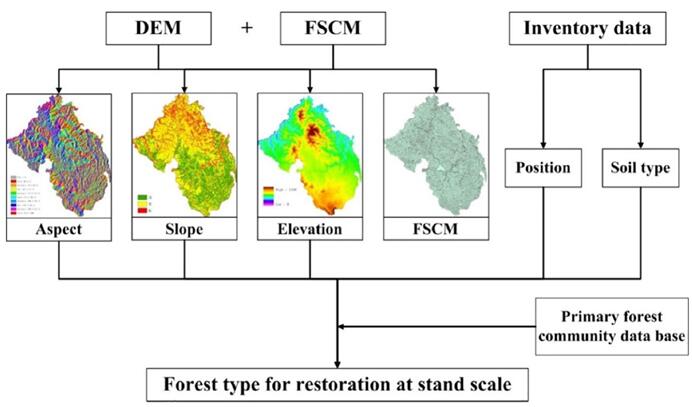
Natural forest degradation caused by human activities is one of the most serious problems that threaten human wellbeing and biodiversity conservation. Although great efforts have been paid, there are yet no general and effective solutions for linking planning at a landscape scale and implementation at an ecosystem scale.
The main reason is that most plans for forest landscape restoration projects make "top-down" policies or decisions at a larger scale, in which landscape structure, regional ecosystem services are the primary concern. On the other hand, the implement of forest landscape restoration is a "bottom-up" process, which focuses on restoring several specific ecosystems to gain target ecosystem structure and function.
To explore solutions to the mentioned challenges, Dr. QI Lin from the Institute of Applied Ecology of the Chinese Academy of Sciences and his colleagues developed a new restoration approach that considers stand conditions based on recent-historical forests in combination with an assessment of several potential forest landscape structure indexes to identify potential restoration plans at multiple scales.
The researchers tested the approach in the management of forests in Changbai Mountains. They identified 14 local native primary forests that in response to different topographies in the study area with data from previous studies and forest inventory data. Then they extracted stand condition data from a digital elevation model and forest inventory data.
Combining the topography data with the native primary forests, they identified the forest types for restoration in each forest stand. Based on the landscape structure analyses, the optimal arrangement of forest types for restoration at landscape scale was determined. Integrating landscape restoration target and potential forest types for restoration of each sub-compartment, the locations and species for restoration were finally determined.
Their approach emphasized the inclusion of habitat-based targeted forest type selection combined with goals to benefit landscape structure and functions, and provided an important bridge from stand scale implementation of actions to landscape decision-making processes.
Published in Ecological Engineering, this study provides a significant baseline for forest restoration and increase restoration effects.
The research was supported by the National Natural Science Foundation of China, National Key Technologies R&D Program of China, and CAS Pioneer Hundred Talents Program.

Fig. 1 Framework of identifying the community for restoration at an ecosystem scale based on stand condition. DEM: Digital elevation model; FSCM: Forest sub-compartment map. (Image by QI Lin)

Fig.2 Optimal arrangement of restored forests at landscape scale. (Image by QI Lin)

Fig.3 Forest management map (Image by QI Lin)

86-10-68597521 (day)
86-10-68597289 (night)

52 Sanlihe Rd., Xicheng District,
Beijing, China (100864)

